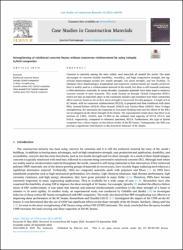| dc.contributor.author | Çakır, Ferit | en_US |
| dc.contributor.author | Acar, Volkan | en_US |
| dc.contributor.author | Aydın, Muhammet Raci | en_US |
| dc.contributor.author | Akşar, Bora | en_US |
| dc.contributor.author | Yıldırım, Pınar | en_US |
| dc.date.accessioned | 2021-10-20T20:08:58Z | |
| dc.date.available | 2021-10-20T20:08:58Z | |
| dc.date.issued | 2021-12 | |
| dc.identifier.citation | Çakır, F., Acar, V., Aydın, M. R., Akşar, B. & Yıldırım, P. (2021). Strengthening of reinforced concrete beams without transverse reinforcement by using intraply hybrid composites. Case Studies in Construction Materials, 15, 1-21. doi:10.1016/j.cscm.2021.e00700 | en_US |
| dc.identifier.issn | 2214-5095 | |
| dc.identifier.uri | https://hdl.handle.net/11729/3243 | |
| dc.identifier.uri | http://dx.doi.org/10.1016/j.cscm.2021.e00700 | |
| dc.description.abstract | Concrete is currently among the most widely used materials all around the world. The main advantages of concrete include durability, versatility, and high compressive strength, but significant disadvantages include low tensile strength, low shear strength, and low ductility. To eliminate these disadvantages, longitudinal and transverse reinforcements are usually preferred. Steel is widely used as a reinforcement material in the world, but there is still research underway to find alternative materials. In recent decades, composite materials have been used to reinforce concrete instead of steel materials. This study focuses on Intraply Hybrid Composites (IHCs), which are had an important place in the composite industry and examines how these composites affect concrete beams as far as their shear strength is concerned. For this purpose, A length of 2 m RC beams, with no transverse reinforcement (RC2.0), is prepared and then reinforced with three IHCs, Aramid-Carbon (AC2.0), Glass-Aramid (GA2.0) and Carbon-Glass (CG2.0). After U-shape strengthening, the specimens are inspected in four-point bending tests and the effects of the IHCs are investigated on the shear strength of the beams. The experimental results show that there is an increase of 4.36%, 10.62%, and 15.28% in the ultimate load capacity of AC2.0, CG2.0, and GA2.0, respectively, compared to reference specimen, RC2.0. Furthermore, the type of hybrid composite has a direct impact on the failure modes of the RC beams. Consequently, the IHCs can provide a significant contribution to the structural behavior of RC beams. | en_US |
| dc.language.iso | eng | en_US |
| dc.publisher | Elsevier Ltd | en_US |
| dc.relation.isversionof | 10.1016/j.cscm.2021.e00700 | |
| dc.rights | info:eu-repo/semantics/openAccess | en_US |
| dc.subject | Aramid-carbon (AC) hybrid composite | en_US |
| dc.subject | Carbon-glass (CG) hybrid composite | en_US |
| dc.subject | Glass-aramid (GA) hybrid composite | en_US |
| dc.subject | Intraply hybrid composites | en_US |
| dc.subject | Reinforced concrete beams | en_US |
| dc.subject | U-shape strengthening | en_US |
| dc.subject | Shear | en_US |
| dc.subject | FRP | |
| dc.subject | Behavior | en_US |
| dc.subject | Fatigue | en_US |
| dc.subject | Repair | en_US |
| dc.title | Strengthening of reinforced concrete beams without transverse reinforcement by using intraply hybrid composites | en_US |
| dc.type | article | en_US |
| dc.description.version | Publisher's Version | en_US |
| dc.relation.journal | Case Studies in Construction Materials | en_US |
| dc.contributor.department | Işık Üniversitesi, Mühendislik Fakültesi, İnşaat Mühendisliği Bölümü | en_US |
| dc.contributor.department | Işık University, Faculty of Engineering, Department of Civil Engineering | en_US |
| dc.contributor.authorID | 0000-0002-3522-1351 | |
| dc.identifier.volume | 15 | |
| dc.identifier.startpage | 1 | |
| dc.identifier.endpage | 21 | |
| dc.peerreviewed | Yes | en_US |
| dc.publicationstatus | Published | en_US |
| dc.relation.publicationcategory | Makale - Uluslararası Hakemli Dergi - Kurum Öğretim Elemanı | en_US |
| dc.contributor.institutionauthor | Akşar, Bora | en_US |
| dc.relation.index | WOS | en_US |
| dc.relation.index | Scopus | en_US |
| dc.relation.index | Science Citation Index Expanded (SCI-EXPANDED) | en_US |
| dc.description.quality | Q1 | |
| dc.description.wosid | WOS:000708124700003 | |



















